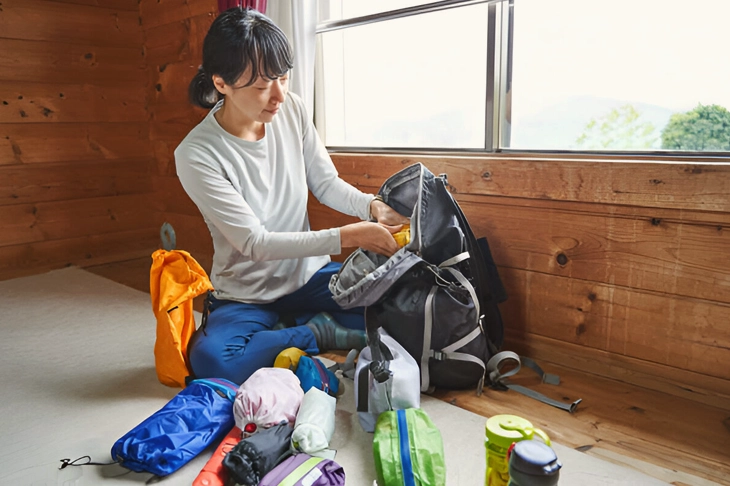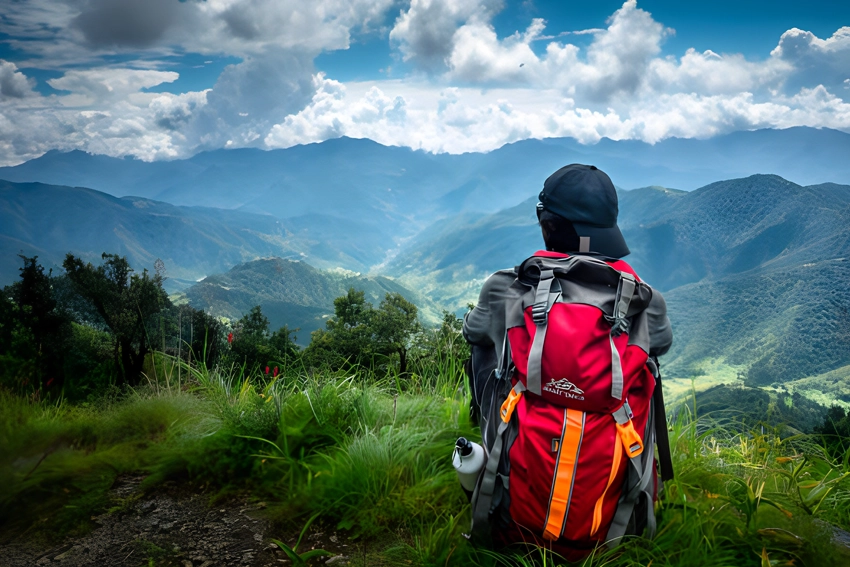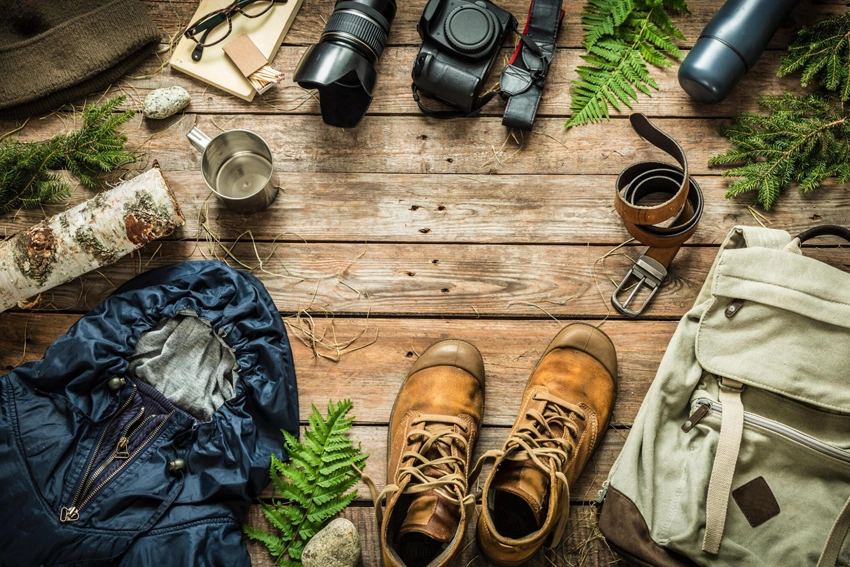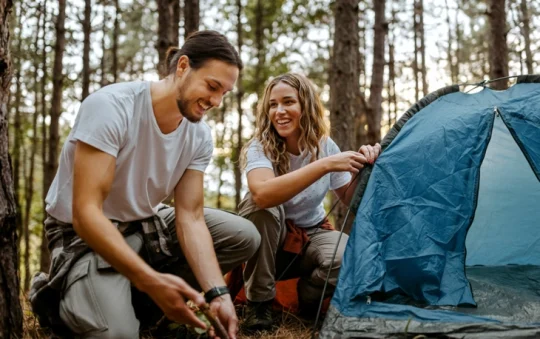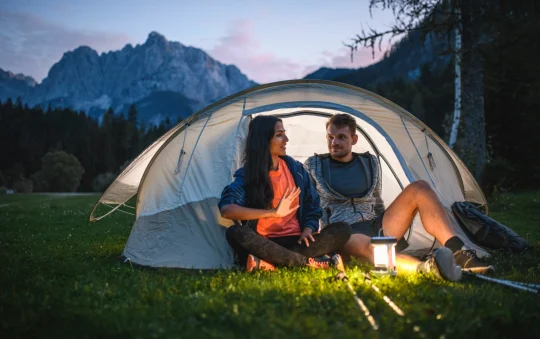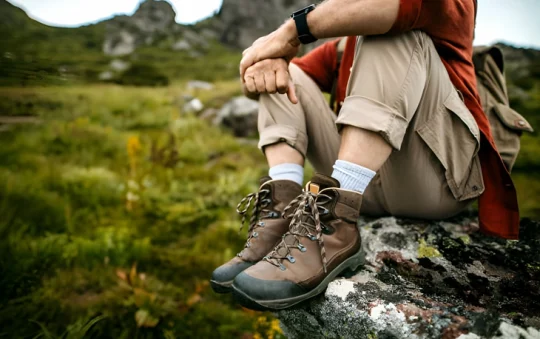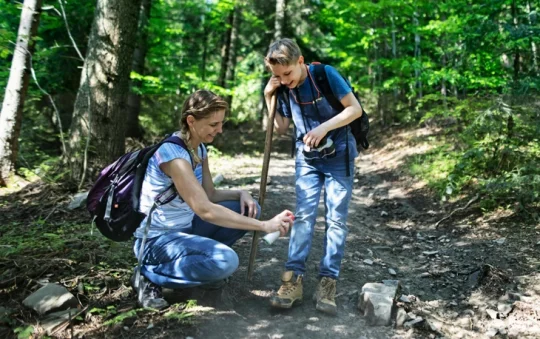Gear Selection and Essential Packing
Picking the right gear is key to traveling light. Here are some simple tips to help you choose equipment that makes your adventures easier:
Go for Lightweight Luggage
Pick backpacks or suitcases made from sturdy but lightweight materials like nylon or polyester. These materials are not only durable but also resist wear and tear from constant handling and travel.
Features like padded straps, wheels, and multiple compartments can make carrying and organizing your stuff a breeze. When choosing your luggage, consider options with compression straps or expandable compartments, allowing you to pack more without adding extra weight.
Pack Versatile Clothing
Choose clothes that mix and match easily for different outfits. Neutral colors like black, gray, and beige work well because they can be dressed up or down, giving you more options with fewer items. Look for clothing made from moisture-wicking fabrics that dry quickly and resist wrinkles.
This way, you can stay comfortable and fresh during your travels, without needing to worry about excessive ironing or bulky laundry loads. Don’t forget to pack layers that can adapt to different weather conditions, making your outfits even more versatile.
Choose Compact Accessories
Opt for small, lightweight versions of travel essentials like towels, toiletry bags, and electronics. Travel-sized versions of everything you need will save space and reduce clutter in your luggage.
You can even find foldable items like hats, bags, and shoes that take up minimal space but still serve their purpose. When it comes to electronics, look for multi-functional devices, such as a portable charger with a built-in flashlight or a travel adapter with USB ports, that eliminate the need for extra accessories.
Use Travel-Sized Toiletries
Skip the big bottles—bring travel-sized toiletries or transfer what you need into reusable containers. This saves space and keeps your bag light, especially if you’re limited by airline baggage restrictions. Opt for solid bars like soap, shampoo, and deodorant, which are even more compact and don’t count toward liquid limits. Keep your toiletries organized in a hanging toiletry bag, allowing you to easily access everything without taking up valuable space in your main luggage.
Stick to the Basics
Only pack the gadgets you’ll actually use, like a smartphone, portable charger, and maybe a camera. If your phone has a good camera, you can leave the extra gear behind, simplifying your packing process. Bring along a power bank to keep your devices charged on the go, especially for long travel days. Consider downloading offline maps and travel apps ahead of time, so you can rely on your phone for all your navigation and entertainment needs, eliminating the need for additional gadgets.
By focusing on lightweight, versatile gear, you’ll have more space for souvenirs and less hassle during your trip. This approach ensures that you can travel smarter, with everything you need at your fingertips, without the burden of overpacking.
Packing Methods and Techniques
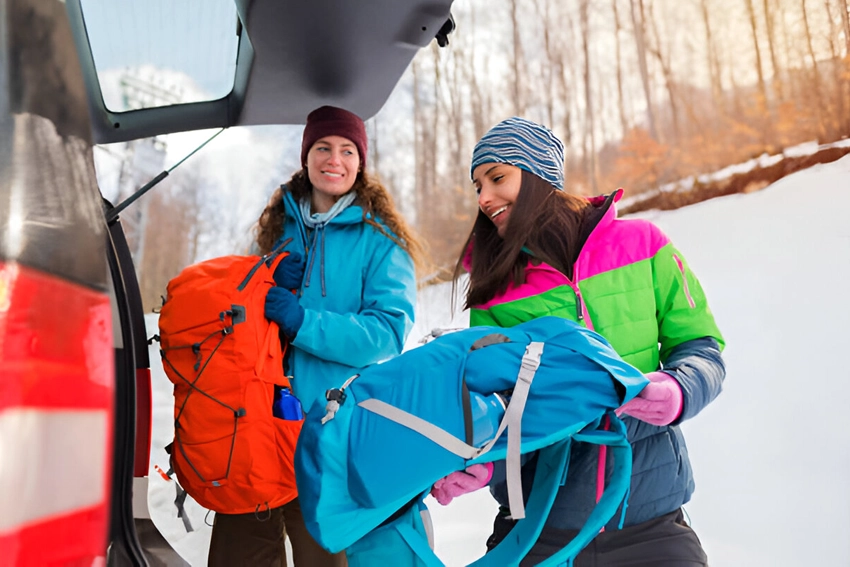
Packing efficiently is the secret to traveling light and staying organized. Here are some simple tips to help you pack smart:
Roll Your Clothes
Skip folding—roll your clothes tightly instead. This method saves space, reduces wrinkles, and lets you fit more into your bag without adding bulk. Rolling also prevents clothes from shifting around and getting creased during travel. Consider rolling smaller items like t-shirts and pants, while folding bulkier items like jackets or sweaters.
If you’re traveling with delicate fabrics, rolling them gently can help keep them from getting damaged. Additionally, rolling creates a neat and easy-to-access pile, so you can easily grab what you need without disturbing the rest of your packed items.
Use Packing Cubes
Organize your clothes with packing cubes or compression sacks. These help keep your items neat and separate, so you can easily find what you need without unpacking everything. Packing cubes also allow you to categorize your belongings, making it easier to access specific items quickly—whether it’s a pair of shoes or a change of clothes.
Some compression sacks can reduce the volume of bulkier items like jackets or sweaters, freeing up space for other essentials. Opt for cubes with breathable mesh panels, so your clothes stay fresh and aired out during long trips.
Maximize Shoe Space
Stuff socks, underwear, or other small items inside your shoes. This saves space and helps your shoes hold their shape during the trip. You can also pack shoes in shoe bags to keep them separate from your clothes, preventing dirt and grime from transferring.
When packing multiple pairs, consider wearing the bulkiest shoes during travel to save precious bag space. For longer trips, pack shoes that are versatile enough for different occasions, minimizing the need for extra pairs and ensuring that your bag remains light and efficient.
Place Heavy Items at the Bottom
Pack heavier items, like shoes or toiletry bags, at the bottom of your suitcase. This balances the weight and keeps your bag stable. By placing heavier items closest to the wheels, you prevent your suitcase from toppling over and maintain better control when moving it.
For duffel bags or backpacks, placing heavier items closer to your back helps distribute the weight evenly and prevents strain on your shoulders. To ensure that your lighter items remain undisturbed, place them on top so they don’t get squished or lose their shape.
Cut Down on Extras
Pack only the essentials. Be honest about what you’ll actually need to avoid carrying unnecessary items. This means considering how many pairs of shoes, clothes, or gadgets you truly require. For example, if you’re going on a beach trip, you might not need more than two pairs of sandals—one for walking and one for the water.
Consider opting for multi-purpose items, such as a lightweight jacket that can double as a pillow, to cut down on bulk. The fewer items you pack, the more space you’ll have to bring back souvenirs or personal items you pick up along the way.
Fill Empty Spaces
Use gaps between clothes or around odd-shaped items to tuck in smaller things like socks or accessories. This maximizes your space and keeps your bag organized. The small pockets and nooks in your luggage can also be used to hold toiletries, chargers, or jewelry.
Roll up small items like scarves or belts and tuck them into any available spaces to save room. If you’re using packing cubes, you can also stuff any leftover gaps in those cubes to ensure every inch of space is utilized efficiently.
By following these tips, you’ll pack more efficiently, stay organized, and make the most of your travel experience. The key to traveling light is choosing the right techniques that not only maximize your bag’s capacity but also keep your belongings easy to access, organized, and in good condition throughout your journey.
Prioritizing Essential Items for Packing Light
Packing smart can make your travel experience smoother and more enjoyable. Here are some simple tips for deciding what to bring:
Clothing
Choose versatile clothes that mix and match easily for different outfits. Neutral colors work well because they can be paired in multiple combinations, giving you more outfit options with fewer pieces. Consider the weather and planned activities at your destination to pack just what you’ll need, whether it’s lightweight clothing for hot climates or layering pieces for cooler destinations.
Focus on packing items that are lightweight, moisture-wicking, and quick-drying, so you can stay comfortable and fresh throughout your trip without worrying about laundry. If you’re heading on an active adventure, remember to pack clothes suited for those activities, like breathable workout gear or hiking shoes.
Toiletries
Stick to travel-sized toiletries or plan to buy them at your destination. Bringing only what you need reduces the bulk in your bag and saves you space. Focus on the basics like toothpaste, shampoo, soap, and deodorant.
You can even find 2-in-1 products like shampoo and conditioner or toothpaste with a built-in toothbrush for further convenience. Consider reusable containers or solid alternatives (like soap bars or solid deodorants) to avoid liquids that can spill or exceed airport security limits. If you’re traveling for an extended period, plan to purchase items at your destination to keep your packing list light and manageable.
Medication
Pack any required medications in their original packaging to avoid issues with airport security or customs. This ensures you have what you need without complications during your trip and can prove that the medications are legally yours if asked.
If you’re traveling internationally, check with local regulations to ensure your medications are allowed, and always carry a copy of your prescription. If you take medications regularly, pack a little extra to cover any unexpected delays, and keep it in your carry-on bag so it’s easily accessible. Consider packing a basic first aid kit with essentials like pain relievers, allergy meds, or motion sickness tablets.
Travel Documents
Keep essentials like your passport, ID, and itinerary in a secure spot, preferably in a travel wallet or neck pouch that’s easy to access but hard for pickpockets to reach. It’s a good idea to have copies or digital backups of these documents in case they’re lost or stolen.
Make a photo or digital scan of your important documents and store them in a cloud service, so you can quickly retrieve them if needed. Additionally, keep emergency contact information and travel insurance details in your wallet or on your phone. This extra layer of preparedness will give you peace of mind throughout your trip.
Electronics
Bring only the gadgets you really need, like your smartphone and charger. While it can be tempting to pack extra devices, limiting your electronics to the essentials will save space, lighten your load, and ensure that you’re focused on enjoying your trip rather than managing multiple devices.
If you plan to use your phone for navigation or entertainment, bring a portable charger to keep your devices powered throughout the day. Consider a multi-port charger to eliminate the need for multiple cords and reduce clutter. If you use your phone’s camera for photos, skip the extra camera equipment and just pack one lightweight, all-in-one solution that covers your photography needs.
By focusing on these essentials, you’ll simplify your packing process, reduce the chances of overpacking, and make your travel experience more enjoyable and stress-free. Packing with purpose ensures you have everything you need without the extra bulk, leaving you more space for the experiences and memories that matter most.
Efficiency Tips for Traveling On-the-Go
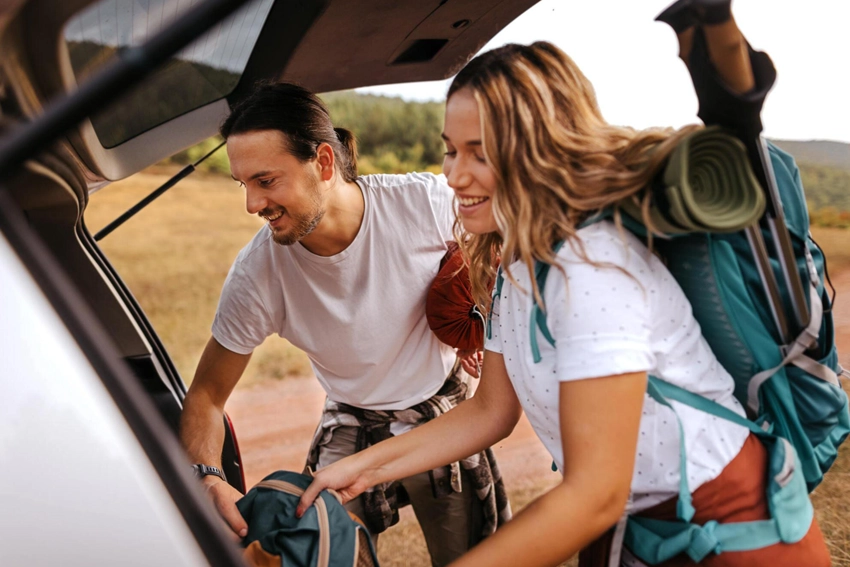
Keep Essentials Close
Store items like your phone, wallet, and passport in easy-to-reach pockets or compartments. This way, you can grab what you need quickly without digging through your bag, which can be especially useful when you’re in transit or going through security.
Consider using a small travel pouch or belt to keep these essentials securely with you at all times, reducing the risk of misplacing them. Having your important items close by also gives you peace of mind, knowing that you have everything you need within reach for any situation. A dedicated, accessible spot for these essentials prevents you from fumbling around in stressful moments, such as at the airport or while navigating busy streets.
Use Packing Cubes
Packing cubes are great for keeping your clothes neat and easy to find. These handy compartments help you organize your clothing by type or outfit, making it easy to pull out exactly what you need without unpacking everything. Whether you use cubes for shirts, pants, or accessories, they reduce clutter and make your bag more organized.
Additionally, packing cubes can help maximize your luggage space by compressing your clothes, so you can fit more in your bag. If you’re traveling with multiple people, consider using different colored cubes for each person’s belongings, making it easier to stay organized and find things quickly.
Plan Ahead
Research transportation options and key attractions before you go. Knowing your routes and plans in advance can save time and reduce stress once you’re at your destination. Consider mapping out your transportation options—whether it’s local buses, trains, or car rentals, and familiarize yourself with the best routes to major landmarks and points of interest.
Planning ahead helps you avoid confusion, ensures you make the most of your time, and may even uncover hidden gems that aren’t on the typical tourist radar. Additionally, check for any special events or closures that could impact your itinerary, so you’re prepared for any changes.
Stay Flexible
Be prepared to adjust your plans if things don’t go as expected. Whether it’s a delayed flight, unexpected weather, or an attraction that’s closed, a flexible attitude helps you adapt to changes and keeps your trip stress-free.
Embrace the spontaneity of travel, knowing that even with a well-planned itinerary, surprises are part of the adventure. Having backup options or alternative activities in mind allows you to stay relaxed and make the most of your time, no matter what happens. Flexibility helps you maintain a positive mindset, especially when faced with unexpected detours or challenges.
Stay Hydrated and Rested
Drink plenty of water and get enough rest to keep your energy up. Traveling can be physically demanding, especially when you’re on the go or adjusting to new time zones, so maintaining your hydration and rest is essential for staying energized and healthy.
Carry a reusable water bottle to ensure you stay hydrated throughout the day and avoid dehydration, which can lead to fatigue. Regular breaks and staying hydrated ensure you have the energy to enjoy every moment of your trip. Whether it’s taking a quick nap, stretching your legs, or grabbing a healthy snack, taking care of your body helps you feel your best and fully enjoy your adventures.
By following these tips, you’ll stay organized, travel more efficiently, and fully enjoy your adventure. Staying organized allows you to make the most of your trip, from the small details to the big experiences, ensuring you can relax and focus on creating memories.
In Conclusion
Traveling light isn’t just about packing less—it’s about simplifying your journey and creating space for incredible experiences. By focusing on what truly matters and leaving behind unnecessary items, you’ll enjoy more freedom and flexibility.
Whether you’re wandering through lively city streets, hiking rugged trails, or soaking in new cultures, traveling light lets you move easily and embrace unexpected opportunities.
As you head out, remember to stay organized, adaptable, and open to new adventures. Enjoy each moment, treasure the memories, and savor the joy of traveling without extra baggage. When you return, your bags will be lighter, and your heart will be full of amazing stories.
For a cozy night under the stars, check out our guide to the best backpacking sleeping bags. Pack smart, travel with purpose, and let the spirit of discovery guide you. Happy travels, and may your journey be full of unforgettable moments.
